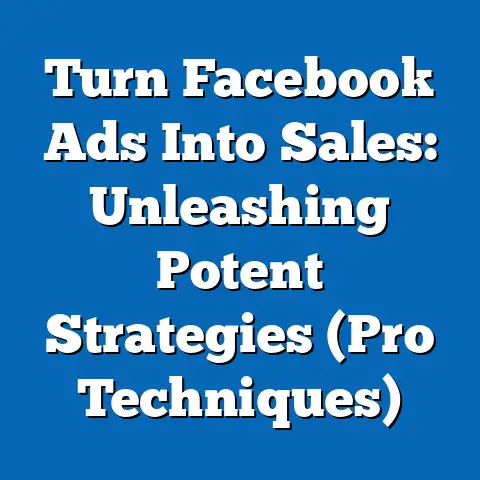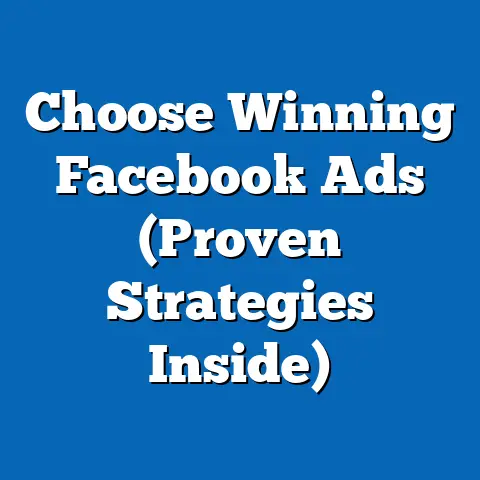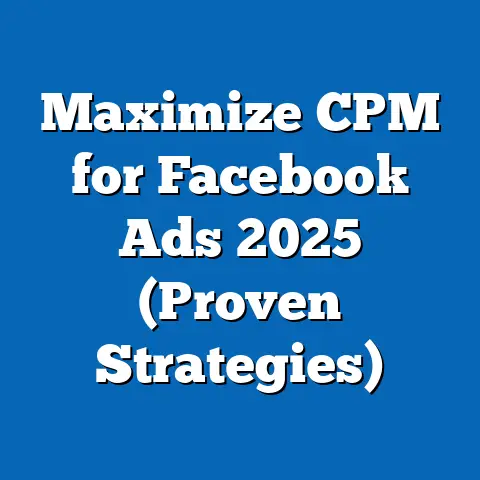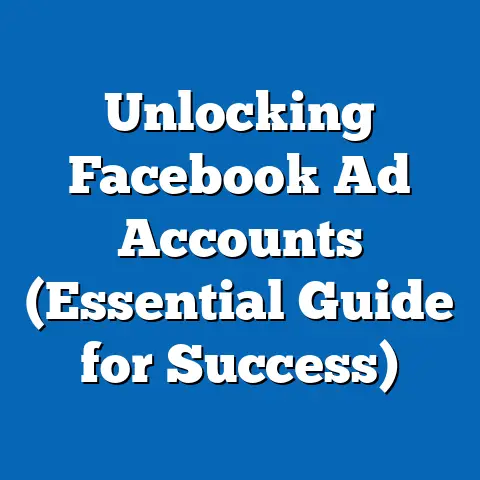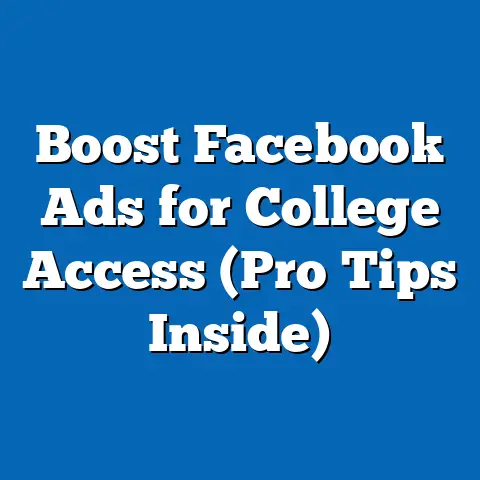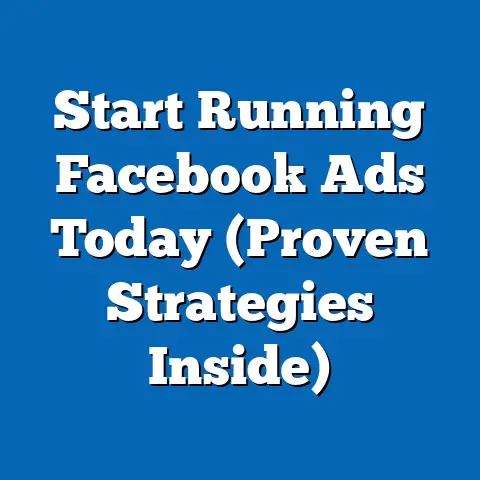Master Facebook Limit Ad Tracking (Pro Strategies Unveiled)
I remember the day iOS 14.5 hit. It felt like a seismic shift in the digital marketing landscape. I was running a campaign for a local boutique, pouring my heart and soul (and budget!) into creating the perfect ads. The targeting was laser-focused, the creative was stunning, and the offer was irresistible. Yet, the results were… lackluster. Conversions plummeted, and my meticulously crafted reports looked more like abstract art than actionable data. It was a frustrating, disheartening experience. I felt like I was driving blindfolded, and the wall was rapidly approaching.
That’s when I realized I needed to understand Limit Ad Tracking (LAT) – and fast. The good news is, I did, and I’m here to share everything I learned, so you don’t have to experience that same sinking feeling. Mastering LAT isn’t just about surviving; it’s about thriving in the new era of privacy-conscious marketing. It’s about turning a potential roadblock into a competitive advantage. It’s about securing your financial freedom by ensuring your marketing dollars are working smarter, not just harder. Let’s dive in!
Understanding Facebook’s Limit Ad Tracking
What is Limit Ad Tracking?
Limit Ad Tracking (LAT) is a privacy feature that allows users to restrict the amount of data that advertisers can collect about their online activity. On iOS devices, this manifests as Apple’s App Tracking Transparency (ATT) framework, which requires apps to ask users for permission to track them across other companies’ apps and websites. Android has its own version, though the implementation details differ.
For advertisers like us, this means that a significant portion of users might opt out of tracking, making it harder to attribute conversions and personalize ads effectively. Think of it like this: before LAT, we had a relatively clear picture of a user’s journey across the web, allowing us to connect ad clicks to website purchases. Now, that picture is often fragmented, with crucial pieces missing.
LAT impacts everything from retargeting to lookalike audience creation. Without accurate tracking, it’s harder to show the right ads to the right people at the right time, leading to wasted ad spend and missed opportunities.
Why Facebook Implemented Limit Ad Tracking
Facebook didn’t implement LAT; it was largely driven by Apple’s ATT framework and broader industry trends towards prioritizing user privacy. However, Facebook had to adapt to this new reality. The motivations behind this shift are multifaceted:
- Regulatory Pressure: Governments worldwide are increasingly scrutinizing data privacy practices. Laws like GDPR in Europe and CCPA in California have set a new standard for data protection, forcing companies to prioritize user consent and transparency.
- User Demand for Privacy: Consumers are becoming more aware of how their data is being collected and used. They are demanding more control over their personal information and are more likely to opt out of tracking if given the choice.
- Competitive Advantage (for Apple): While not the only reason, Apple’s ATT framework arguably gave them a competitive edge. By positioning themselves as champions of user privacy, they attracted users who valued data protection.
These changes have fundamentally altered the advertising landscape. We’ve moved from a world of abundant data to one where data is more scarce and carefully guarded. This requires a paradigm shift in how we approach digital marketing, emphasizing ethical data collection, transparent practices, and creative solutions.
The Challenges of Limit Ad Tracking
The Ripple Effect on Campaign Performance
Limit Ad Tracking has a direct and often significant impact on key campaign performance metrics. I’ve seen firsthand how it can throw a wrench into even the most carefully planned strategies. Here’s a breakdown of the key areas affected:
- Conversion Tracking: This is perhaps the most obvious impact. When users opt out of tracking, it becomes harder to accurately attribute conversions to specific ad campaigns. This makes it difficult to measure ROI and optimize campaigns effectively. I’ve seen conversion attribution drop by as much as 30-40% in some cases.
- Retargeting: Retargeting relies on tracking users who have previously interacted with your website or app. With LAT, a significant portion of these users become invisible, making it harder to re-engage them with targeted ads.
- Lookalike Audiences: Lookalike audiences are created by identifying users who share similar characteristics with your existing customers. If your seed audience is based on tracked data that is now incomplete, your lookalike audiences will also be less accurate.
- Personalization: Effective ad personalization relies on understanding user preferences and behavior. LAT makes it harder to gather this information, leading to less relevant and less engaging ads.
- Reporting Accuracy: Overall, LAT reduces the accuracy of Facebook’s reporting. The data we see in Ads Manager is no longer a complete representation of reality, making it harder to make informed decisions.
A recent study by Singular found that iOS 14.5 cost Facebook advertisers an estimated $10 billion in revenue in 2021 alone. While the impact varies depending on the industry and target audience, there’s no doubt that LAT has created significant challenges for marketers.
Common Misconceptions
One of the biggest mistakes I see marketers make is assuming that LAT means the complete death of tracking. That’s simply not true. Here are some common misconceptions:
- “LAT means I can’t track anything anymore.” Not true! While LAT does limit tracking, it doesn’t eliminate it entirely. Facebook still collects some aggregated and anonymized data, and you can still track users who opt in to tracking.
- “Facebook ads are useless now.” Again, not true! Facebook ads are still a powerful tool for reaching a large audience and driving business results. However, you need to adapt your strategies to account for LAT.
- “There’s nothing I can do about LAT.” Absolutely not! There are many strategies you can implement to mitigate the impact of LAT, which I’ll cover in the next section.
- “Just ignore LAT and hope it goes away.” This is the worst approach. Ignoring LAT will only lead to wasted ad spend and missed opportunities. You need to proactively address the challenges it presents.
It’s crucial to understand that LAT is not a binary switch – it’s a spectrum. Some users will opt in to tracking, some will opt out entirely, and others will fall somewhere in between. The key is to develop strategies that work across this spectrum and maximize the data you do have.
Pro Strategies to Overcome Limit Ad Tracking
Okay, so LAT is a challenge, but it’s not insurmountable. I’ve spent the past few years experimenting with different strategies and have found several that work effectively. Here are my top recommendations:
Embracing First-Party Data
In the age of privacy, first-party data is gold. First-party data is information you collect directly from your customers, such as email addresses, purchase history, and website activity. Because users willingly provide this data, it’s not subject to the same restrictions as third-party data (data collected by other companies).
Here’s how to leverage first-party data effectively:
- Build Your Email List: Email marketing is more important than ever. Encourage users to sign up for your email list by offering valuable incentives, such as exclusive discounts, free content, or early access to new products. I’ve used lead magnets like free e-books or checklists to significantly grow my email list.
- Implement Customer Relationship Management (CRM): A CRM system allows you to store and manage your customer data in a centralized location. This makes it easier to segment your audience, personalize your messaging, and track customer interactions.
- Create Custom Audiences: Upload your first-party data to Facebook to create Custom Audiences. This allows you to target your existing customers with highly relevant ads. Even with LAT, Facebook can often match a significant portion of your customer data to Facebook profiles.
- Use Customer Surveys and Feedback: Directly ask your customers about their preferences and needs. This provides valuable insights that can inform your ad targeting and creative.
- Website Tracking with Consent: Ensure you have clear and transparent consent mechanisms on your website for collecting data. Offer users the option to opt in to tracking, and clearly explain the benefits of doing so.
By focusing on building and leveraging your own first-party data, you can significantly reduce your reliance on third-party tracking and improve the effectiveness of your Facebook ad campaigns.
Leveraging Facebook’s Advanced Features
Facebook offers several advanced features that can help mitigate the impact of LAT. Here are some of the most important:
- Aggregated Event Measurement (AEM): AEM is a Facebook protocol designed to measure website events from users who have opted out of tracking. It allows you to prioritize up to eight conversion events per domain, providing some visibility into campaign performance even with limited data. Setting this up correctly is crucial.
- Conversion API (CAPI): The Conversion API (formerly known as Server-Side API) allows you to send conversion data directly from your server to Facebook, bypassing the limitations of browser-based tracking. This is a more reliable and accurate way to track conversions, especially for users who have opted out of tracking. Implementing CAPI requires some technical expertise, but it’s well worth the investment.
- Value-Based Lookalike Audiences: Instead of creating lookalike audiences based on general website visitors, focus on creating them based on your highest-value customers. This can improve the accuracy and effectiveness of your lookalike targeting.
- Collaborative Ads: Collaborative Ads allow you to partner with other businesses to reach their audiences. This can be a great way to expand your reach and acquire new customers, especially if you’re targeting a niche market.
- Facebook Pixel Setup and Optimization: Ensure your Facebook Pixel is properly installed and configured on your website. Double-check that you’re tracking all relevant events and that your pixel is firing correctly. This sounds basic, but I’ve seen countless accounts where the pixel was improperly set up, leading to inaccurate data.
By mastering these advanced features, you can significantly improve the accuracy and effectiveness of your Facebook ad campaigns, even in the face of LAT.
Exploring Alternative Tracking Solutions
While Facebook’s features are essential, it’s also wise to explore alternative tracking solutions that can provide additional insights and data accuracy. Here are a few options:
- Google Analytics: Google Analytics is a powerful web analytics platform that can provide valuable insights into user behavior on your website. While it’s also affected by privacy restrictions, it can still offer a broader perspective than Facebook’s reporting alone.
- UTM Parameters: UTM parameters are tags you add to your ad URLs that allow you to track where your traffic is coming from. This is a simple but effective way to measure the performance of your different ad campaigns and identify which sources are driving the most valuable traffic. I always use a UTM builder to ensure consistency.
- Server-Side Tracking: As mentioned earlier, server-side tracking (via Facebook’s Conversion API or other solutions) is a more reliable way to track conversions, as it bypasses browser-based tracking limitations.
- Attribution Modeling: Explore different attribution models to understand how different touchpoints contribute to conversions. Facebook’s default attribution model may not be the most accurate in the age of LAT, so experiment with other options like time decay or linear attribution.
- Third-Party Attribution Tools: Consider using a third-party attribution tool like Branch or AppsFlyer to get a more holistic view of your marketing performance across different channels.
By combining these alternative tracking solutions with Facebook’s features, you can create a more complete and accurate picture of your marketing performance.
Real-World Examples and Case Studies
Theory is great, but seeing these strategies in action is even better. Let’s look at some real-world examples of how brands have successfully adapted to LAT:
Success Stories of Adaptation
- Example 1: E-commerce Brand Focusing on Email Marketing: An e-commerce brand selling sustainable clothing saw a significant drop in conversion tracking after iOS 14.5. They doubled down on email marketing, offering exclusive discounts to subscribers and segmenting their audience based on purchase history. As a result, they were able to increase their email conversion rate by 25% and offset the losses from reduced Facebook tracking.
- Example 2: SaaS Company Implementing Conversion API: A SaaS company offering project management software implemented Facebook’s Conversion API. This allowed them to track sign-ups and trial conversions more accurately, even for users who had opted out of tracking. They saw a 15% increase in attributed conversions after implementing CAPI.
- Example 3: Local Restaurant Leveraging First-Party Data: A local restaurant started collecting customer email addresses at the point of sale and using them to create Custom Audiences on Facebook. They targeted these customers with ads promoting special offers and events, resulting in a 20% increase in foot traffic.
These examples demonstrate that it’s possible to thrive in the age of LAT by adapting your strategies and focusing on ethical data collection, transparent practices, and creative solutions.
Key Takeaways from Industry Experts
I’ve also spoken with several industry experts about LAT, and their insights are invaluable:
- “Privacy is not a fad; it’s a fundamental shift in consumer expectations. Marketers need to embrace this change and build trust with their audiences by being transparent about their data practices.” – Sarah Thompson, Digital Marketing Consultant
- “First-party data is the new oil. Companies that can effectively collect and leverage their own data will have a significant competitive advantage in the years to come.” – John Anderson, CEO of Marketing Analytics Firm
- “Don’t put all your eggs in one basket. Diversify your marketing channels and explore alternative tracking solutions to reduce your reliance on Facebook’s data.” – Maria Rodriguez, Social Media Strategist
These quotes reinforce the importance of adapting to the new privacy landscape and focusing on ethical, sustainable marketing practices.
Conclusion
Remember my initial frustration with iOS 14.5? It felt like the end of the world. But it wasn’t. It was an opportunity. An opportunity to become a better marketer, to build stronger relationships with my customers, and to create more effective and ethical campaigns.
Mastering Facebook Limit Ad Tracking is not just about overcoming a challenge; it’s about embracing a new era of privacy-conscious marketing. It’s about building trust with your audience, collecting data ethically, and leveraging creative solutions to achieve your business goals.
I encourage you to take action today. Start by building your email list, implementing the Conversion API, and exploring alternative tracking solutions. Don’t be afraid to experiment and try new things. The digital marketing landscape is constantly evolving, and the key to success is to be adaptable and always willing to learn.
By mastering Facebook Limit Ad Tracking, you can unlock greater marketing success, secure your financial freedom, and achieve your full potential as a digital marketer. Now go out there and conquer the challenges of the new privacy landscape!

